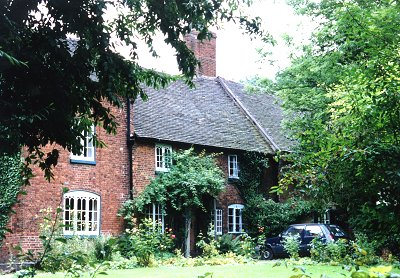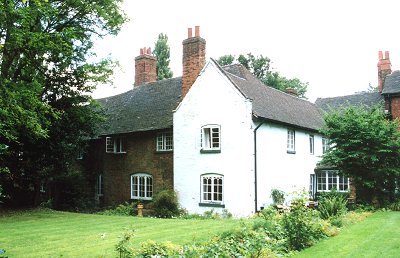|

The west end of the building, sometimes referred to as Graiseley Old
Cottage.
Listing: late C15 with early C18 and later alterations. Brick with
some plaster and internal timber-framed structure. One of the oldest buildings
in the borough with many surviving C15 and C16 features.
Literature:
Pevsner: this ancient, important and interesting building has achieved the
distinction of being "not in Pevsner". While Homer nods, Pevsner notes the
Bushbury swimming baths.
Frank Mason managed two volumes of Wolverhampton's history but not one
mention of Graseley Old Hall.
Chris Upton's History of Wolverhampton does make reference to it: pp. 18 and
20.
Gerald Mander, in his History of Wolverhampton, pompously refers to "Graseley
- (I prefer the correct spelling)" but, in that book, that is about all this
genuine building gets from a resident of Wightwick Manor. However his notes on
the Hall were printed in F. L. Steward, A History of the Royal Wolverhampton
School 1850 - 1950, Steens (Wolverhampton), 1950, at pp. 80 - 81, wherein he
says much about the owners and little about the building.
Comment:
|

The central part - the east end runs off to the left. |
It was only in 1957 that anyone seems to have noticed the
building as being of historic interest. In that year Enoch
Powell, the local MP, drew it to the attention of the
appropriate government department, and it was listed.
|
Mander says: Graseley was "moated, a precaution against cattle-lifters, and
there are still indications of this at Graseley. The present house was built at
the end of the 15th century, and is the oldest building in Wolverhampton after
St.Peter's Church." "The interior of the house, after the careful restoration by
Mr. George Green, preserves much of its Tudor original, the ceilings and walls
having been kept in position. In one place a specimen is preserved of the old
wattle, and the moulded ceiling is original. The exterior timberwork was
replaced in brick about the time of Queen Anne, probably by John Jesson,
formerly of West Bromwich, who dies at Graseley in 1712."
The listing is probably accurate but the house could do with a much more
thorough survey in order to sort out its history. Part of the house may in fact
predate the late 15th century. The outside now gives the appearance of a range
of brick cottages, making a varied and picturesque scene. There is nothing left
of any external timbering but some of the roof lines betray the early origins of
the interior. The interior still has readily visible many fine pieces of timber
work, some with remarkable medieval paintings on them. The earliest roof space
reveals purlins made out of old ship's timbers. Buildings are often said to be
built of ship's timbers and this is sometimes explained as a refrence to the
quality of the timber, not its origins. The use of ship's timber is often
quoted between here and the Severn but this is the only clear example of the
timber from a ship actually being used.
How "careful" the restoration of Mr. George Green was is not clear. At the
time he was the Borough Surveyor, a position which may have given him access to
the old wood from St. Peter's Church which he used around the house.
This house has been around for more than 500 years and has grown and changed
over that time. It is the effect of that which Edward Ould claimed to be
recapturing at Wightwick Manor in the 1890s. The
result there is, of course, nothing like the real thing.
Whether or not this is the oldest building in Wolverhampton, other than St.
Peter's, rather depends on how you define "building" and "Wolverhampton". It is
very probably the oldest residential building within the current boundaries of
the Wolverhampton City Council but in 2001 new research indicated that
Merridale Old Farm has even earlier origins.
Graseley Old Hall is now a privately owned residence and is not normally open
to the public. But rooms can also be made available for meetings and
similar functions. Contact Susan Williams at the Old Hall.

|